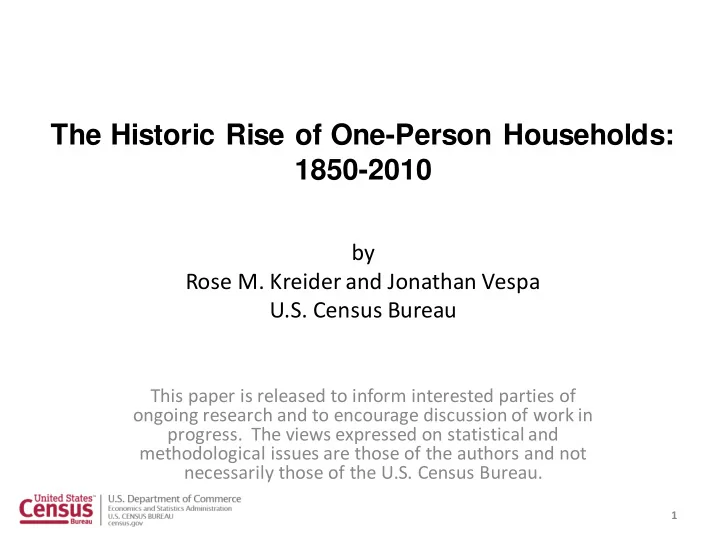

The Historic Rise of One-Person Households: 1850-2010 by Rose M. Kreider and Jonathan Vespa U.S. Census Bureau This paper is released to inform interested parties of ongoing research and to encourage discussion of work in progress. The views expressed on statistical and methodological issues are those of the authors and not necessarily those of the U.S. Census Bureau. 1
The historic rise of living alone: 1850 – 2010 (%) (thousands) 30 36,000 # of one-person households 32,000 28,000 20 24,000 20,000 16,000 % one-person households 10 12,000 8,000 4,000 No data 0 0 1850 ‘60 ‘70 ‘80 ‘90 1900 ‘10 ‘20 ’30 ’40 1950 ‘60 ’70 ‘80 ‘90 2000 ‘10 2
Data Integrated Public Use Microdata Samples (IPUMS)*, 1850-2000 2010 Census internal file * Steven Ruggles, J. Trent Alexander, Katie Genadek, Ronald Goeken, Matthew B. Schroeder, and Matthew Sobek. Integrated Public Use Microdata Series: Version 5.0 [Machine-readable database]. Minneapolis, MN: Minnesota Population Center [producer and distributor], 2010. 3
One-person households by age and sex, 1850 to 2010 (%) 3 4 4 4 5 5 5 6 7 8 10 Women 75+ 8 14 15 7 15 9 17 17 9 9 9 9 11 14 15 18 Women 65-74 10 11 23 16 19 14 29 27 24 26 24 29 31 2 32 3 2 3 2 2 30 3 4 36 Women <65 30 4 5 3 6 7 34 30 29 4 31 8 4 9 5 Men 75+ 4 9 4 4 4 5 4 5 Men 65-74 4 4 5 9 61 7 60 6 55 54 53 52 48 40 34 34 34 31 31 Men <65 27 25 24 1850 1860 1870 1880 1900 1910 1920 1930 1940 1950 1960 1970 1980 1990 2000 2010 Source: Integrated Public Use Microdata Sample (IPUMS) 1850-2000, 2010 Census. Differences 4 in percentages between years or within years less than 3 percentage points may not be significantly different due to sampling error.
One-person households by race and sex, 1850 to 2010 (%) 0.0 0.1 0.1 0.1 0.2 0.2 0.1 0.1 0.1 0.2 0.4 0.5 0.9 1.5 2.4 3.2 2.9 Women Other 3.5 6.0 5.8 5.9 5.7 6.9 6.0 7.2 6.0 7.9 7.4 8.1 6.4 6.8 Women Black 7.5 35.9 32.1 31.4 31.0 29.7 32.1 35.6 41.0 46.8 53.6 56.8 58.2 54.3 52.8 47.9 44.4 1.7 0.5 1.7 0.0 0.9 0.5 2.4 3.7 Women White 1.8 11.5 12.2 11.4 9.6 0.8 7.7 7.0 0.5 6.0 3.7 3.1 Men Other 0.4 0.9 1.7 4.2 5.9 0.6 5.2 5.0 4.7 0.5 4.3 Men Black 4.6 63.1 57.1 48.4 47.9 49.5 48.4 47.8 45.1 40.8 35.8 32.3 30.2 33.0 32.9 34.2 35.0 Men White 1850 1860 1870 1880 1900 1910 1920 1930 1940 1950 1960 1970 1980 1990 2000 2010 Source: Integrated Public Use Microdata Sample (IPUMS) 1850-2000, 2010 Census. Differences in 5 percentages between years or within years less than 3 percentage points may not be significantly different due to sampling error.
The historic rise of living alone: 1850 – 2010 (%) 1980 to 2010 30 Omitted in models 20 % one-person 1940 to 1970 households Up to 1930 10 No data 0 1850 ‘60 ‘70 ‘80 ‘90 1900 ‘10 ‘20 ’30 ’40 1950 ‘60 ’70 ‘80 ‘90 2000 ‘10 6
Logistic Regression Models Controls for householder’s characteristics Gender Race (white, black, other) Age 15-34 35-64 65-74 75 and over 7
Model 1: Year and Householder Characteristics Other race Black (White) Age 75 and older Age 65 to 74 (Age 35 to 64) Age 15 to 34 Odds Ratios (Female householder) Male householder (1980 to 2010) 1940 to 1970 1850 to 1930 0.00 2.00 4.00 6.00 8
Macro level variables Life expectancy ( men’s , women’s) Gap in life expectancy (women – men) Age at first marriage (men’s, women’s) Percent white in total US population Real per capita GDP 9
Models with men’s life expectancy Years with higher male life expectancy are associated with lower odds of one-person households In model for those age 65-74, coefficient for 1940-1970 almost doubled after addition of men’s life expectancy: .065 to .118 (odds went from 1.06 to 1.12) 10
Models with per capita GDP Per capita GDP grew from $2,303 in 1850 to $47,710 in 2010 (2010 dollars) Higher per capita GDP is associated with higher percentage of one-person households True for all age groups For those 75+: odds of one-person households are 5.5 times for each logged- unit increment of GDP For those 35-64: odds are 2.0 times as high 11
Decomposition of one-person households (w/ life exp.) Proportion of the Proportion of the compositional Average percent of one- gap due to… changes due to… person households 25 Men’s life . . . compositional expectancy -172% changes in the population 20 1940 – 2010 89% 15 Gap Year 257% 10 1900 – 1930 5 . . . effect of 0 11% 3% covariates Demographic traits 12
Decomposition of one-person households (w/ GDP) Proportion of the Proportion of the compositional Average percent of one- gap due to… changes due to… person households 25 GDP (per capita) . . . compositional changes in the population 20 1940 – 2010 101% 145% 15 Gap 10 Year 1900 – 1930 5 -52% . . . effect of -1% Demographic traits 8% covariates 0 13
Conclusions Men’s life expectancy = 1-person hholds Real per capita GDP = 1-person hholds Decomposition shows: compositional shifts very important for growth of 1-person households Economic factors also have a strong effect on growth of 1-person households 14
Contact Rose Kreider rose.kreider@census.gov Jonathan Vespa jonathan.vespa@census.gov 15
Recommend
More recommend